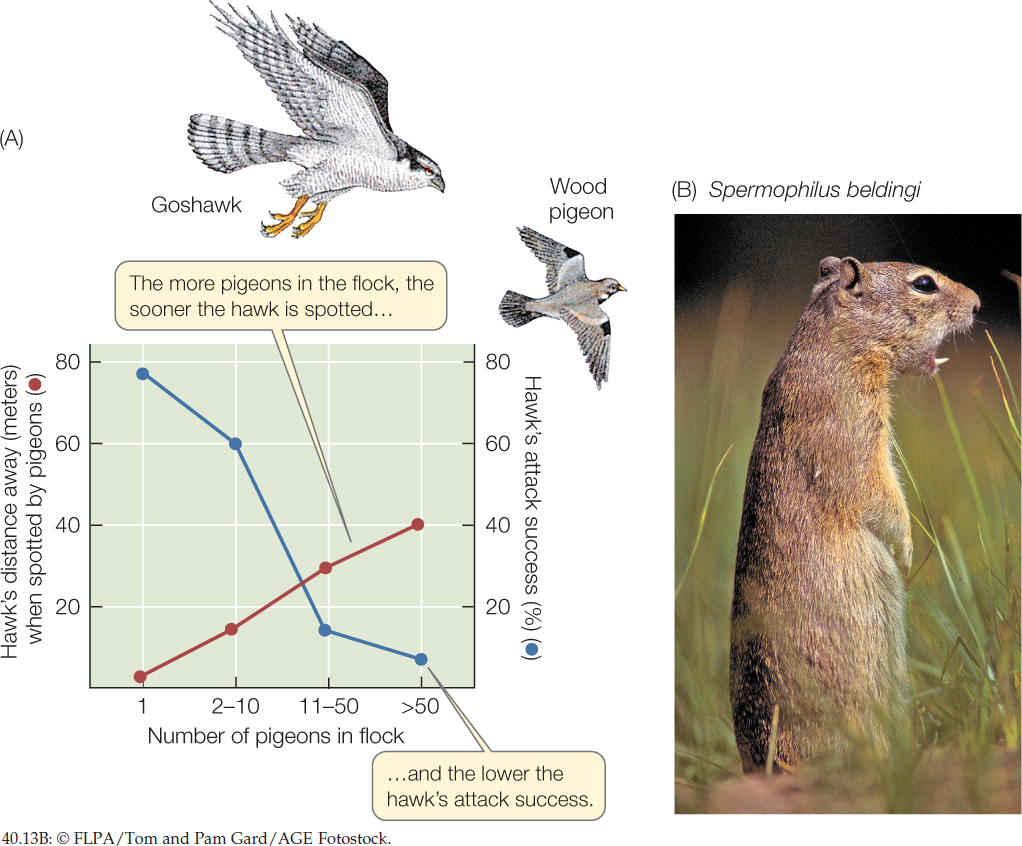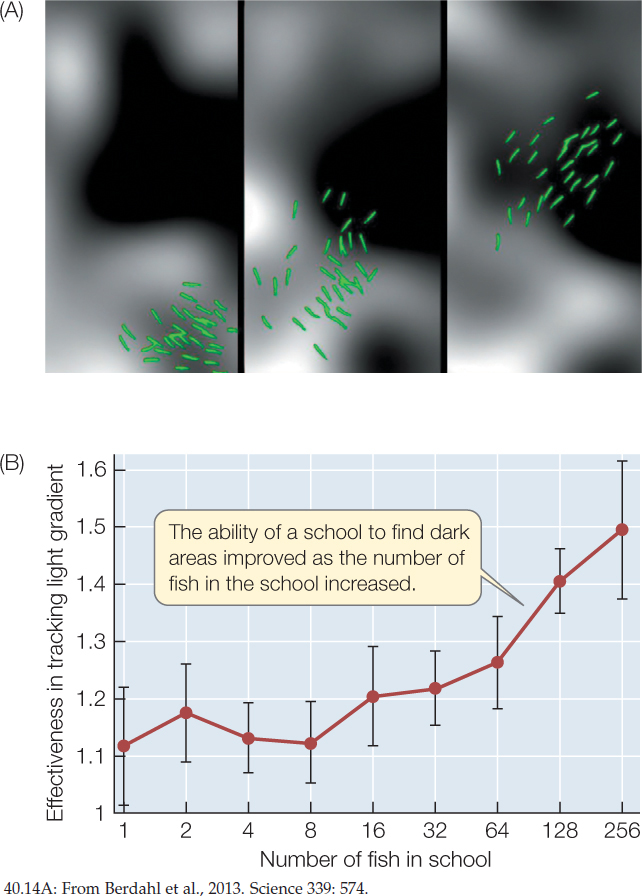CONCEPT40.5 Social Behavior Is Widespread
A moment’s reflection reveals that many animal species live in groups. Flocks of birds, schools of fish, and herds of antelopes are just a few examples. Many types of groups are considered societies. Specialists debate the exact meaning of a “society,” but a broad, commonly used definition is that a society is a group of individuals of a single species, organized to some degree in a cooperative manner. The subject of social behavior includes both the behaviors of individuals that integrate the individuals into societies and the group behaviors of entire societies.
Living in a group has downsides. Grouping tends to make animals more visible. Diseases can spread more easily within a group, and a group may rapidly deplete food or other resources in the place where it is living.
Biologists presume that group living has evolved only if it provides advantages that exceed its disadvantages. Much of the research being done on societies today focuses on testing hypotheses regarding how individuals in a society benefit from living together in a group. Physiological advantages prevail in some cases. Penguins, for example, reduce their thermoregulatory costs in the cold of winter by huddling. Our focus here will be on potential behavioral advantages of group living.
Some societies consist of individuals of equal status
Sometimes the individuals in a flock, school, or herd seem to play similar, approximately equal roles in the function of the group. In a group of this sort, one advantage hypothesized for group living is that a group may enjoy enhanced sensory awareness of its environment because the members of the group can pool their individual sensory capabilities. A group of 50 vertebrate animals has 100 eyes instead of just 2. Groups may therefore have greater awareness of danger than individuals. One investigator found that a trained goshawk’s success in capturing a pigeon in a flock decreased as the number of pigeons in the flock increased (FIGURE 40.13A). The larger the flock, the sooner one of the individuals in the flock spotted the goshawk and started to fly away, stimulating the other individuals to take flight as well. Belding’s ground squirrels, which live in large colonies in open meadows, use alarm calls to reduce predation risk. When an aerial predator such as a hawk arrives overhead, one of the squirrels that first spots the hawk gives a loud whistle (FIGURE 40.13B). Immediately, other individuals also whistle, and the animals run to their burrows or other shelter. Aerial predators almost never capture a ground squirrel after the alarm whistles have begun.

Animals in groups may also discover preferred environments more efficiently. In a recent experiment, investigators studied a species of fish that prefers to be in places where light levels are low. They studied schools of the fish of various sizes in a large aquarium that had both darkened and well-lit areas of water. The darkened areas moved from place to place, so the fish could not simply find a dark spot and stay there. The efficiency with which a school could find dark areas increased dramatically as the number of fish in the school increased (FIGURE 40.14). There is good reason to think that results would be similar if schools were seeking other desirable regions in the water, such as regions with abundant food.

Some societies are composed of individuals of differing status
A group of vervet monkeys (Chlorocebus) typically contains multiple subadult and adult males (FIGURE 40.15), along with females and youngsters. One of the adult males typically dominates all the other adult and subadult males in the group, meaning it “wins” during one-on-one behavioral contests with each of the others. This dominant male has by far the greatest chances of mating with the adult females in the group.
840

Dominance by a particular male is even more evident in impala antelopes (Aepyceros melampus). If you ever go on safari in Africa and encounter a group of impala during the breeding season, you’ll notice the existence of two subgroups. One subgroup consists entirely of males. By marking the animals in this type of subgroup, researchers established that these males do not get to mate with females. The second subgroup consists of a single male and a large number of females. This single male does essentially all of the mating! As you might guess, the dominant male—the single male in the group of females—must expend extraordinary effort to repel intruding males and intercept females that try to leave. This activity is exhausting, and dominant males tend to retain their dominance for only a few months.
LINK
Dominance behaviors may result in sexual selection, which would tend to favor increases in these behaviors in subsequent generations; see Concept 15.2
Within groups in which certain individuals have distinctive status—such as groups of vervet monkeys or antelopes with dominant males—individuals are able to benefit from group living in the same ways we discussed in the last section. In addition, biologists hypothesize that the evolution of social systems based on distinctive status has taken place because such systems can provide additional benefits. In cases of dominant males, researchers currently hypothesize that the process of becoming dominant may often serve as a test of a male’s strength, endurance, and other properties critical for success. Females that mate with the dominant male may thereby ensure that their offspring are genetically well endowed. In this way, both the individual males and the individual females that mate in such systems of social behavior realize advantages.
Eusociality represents an extreme type of differing status
In most animals, all the adult members of a social group are physiologically capable of reproducing, even though some may be behaviorally excluded from reproducing at certain times. An entirely different situation exists in many social insects, such as honey bees.
In a honey bee colony, a single female—the queen—is reproductive and lays eggs. Occasionally she produces a few male offspring (drones) that are fertile, producing sperm. However, most of the thousands of other individuals in the colony—all of which are her offspring—are sterile female worker bees. Similar colony structures occur in many other types of bees, wasps, ants, and termites.
Eusociality refers to a social structure in which some members of a social group are nonreproductive and assist the reproduction of fertile members of the group, typically their mother. It represents an extreme form of differing status within a social group. Nearly all known cases of eusociality occur within the insects, although eusociality is also documented in naked mole rats (Heterocephalus glaber) and certain coral-reef shrimps.
All cases of structured, unequal reproductive status among adults in social groups raise the question of why evolution has produced systems in which the inequality exists. This question reaches its extreme manifestation in the eusocial animals. In discussing such questions, an important concept is altruism. As used in discussions of evolution, altruism refers to any characteristic of an individual that imposes a cost on that individual while aiding another individual. Workers in eusocial colonies exemplify altruism because, whereas they themselves are unable to breed, they help another individual breed. Altruism also occurs if an individual—when seeing a predator—gives warning calls that draw the predator’s attention to itself (endangering its life) while giving neighboring individuals a better chance to hide. The reasons why altruism exists have been hotly debated in evolutionary biology for a half century.
841
CHECKpointCONCEPT40.5
- Name one advantage and one disadvantage of group living.
- Consider the phenomenon of mating exclusion, in which certain adult individuals in a group are excluded from mating. How does mating exclusion differ in groups with a dominant individual and in eusocial groups?
- What is altruism, and why might a biologist have difficulty reconciling it with the theory of evolution by natural selection?
Isolated individuals and entire ecological communities are at opposite ends of a spectrum of complexity in biological systems. Having started this chapter with a focus on individuals, we will now end by looking at some of the ways that behavior is important in communities.